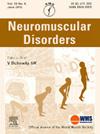面肩肱肌营养不良患者可达工作空间的强度和功能相关性
IF 2.7
4区 医学
Q2 CLINICAL NEUROLOGY
引用次数: 0
摘要
FSHD患者可出现肩胛骨翅和手臂抬起能力丧失。可达工作区(RWS)能够描述上肢(UE)的到达能力。我们分析了175名参加解决FSHD药物开发障碍的临床试验准备(ReSolve)研究的临床影响和遗传确诊的FSHD成人患者的数据。我们的目的是:1)研究UE到达能力和肌肉力量之间的关系(使用定量肌肉测试,QMT);(2)描述不同的接触能力如何对应于患者在家中报告的功能。总相对表面积(即额平面上肢可达性)与QMT测量的UE强度之间存在很强的相关性。总相对表面积每连续减少25%,预测UE强度平均下降18%,上肢功能指数平均下降9点。如promise -57问卷所述,无法到达右上内侧象限的个体在进行各种上肢日常生活活动时更困难,身体功能也有所下降。RWS为FSHD患者的上肢力量和功能提供了有意义的测量。本文章由计算机程序翻译,如有差异,请以英文原文为准。
Strength and functional correlates of reachable workspace in facioscapulohumeral muscular dystrophy
Patients with FSHD can develop scapular winging and loss of ability to raise arm. Reachable workspace (RWS) is able to describe upper extremity (UE) reaching ability. We analyzed data from 175 clinically affected and genetically confirmed adults with FSHD enrolled in the Clinical Trial Readiness to Solve Barriers to Drug Development in FSHD (ReSolve) study. Our objective was to 1) investigate the relationship between UE reaching ability and muscle strength (using quantitative muscle testing, QMT); and (2) describe how different reaching abilities correspond to patient-reported function at home. There were strong correlations between total relative surface area (i.e., upper extremity reachability in the frontal plane) and UE strength measured by QMT. For each successive 25 % decrease in total relative surface area, there was a corresponding mean 18 % decrease in predicted UE strength and a mean 9-point decrease in the Upper Extremity Functional Index. Individuals that could not reach the right upper medial quadrant reported more difficulty performing various upper extremity activities of daily living and had decreases in the physical function as reported by the PROMIS-57 questionnaire. RWS provides a meaningful measurement of upper extremity strength and function in patients with FSHD.
求助全文
通过发布文献求助,成功后即可免费获取论文全文。
去求助
来源期刊

Neuromuscular Disorders
医学-临床神经学
CiteScore
4.60
自引率
3.60%
发文量
543
审稿时长
53 days
期刊介绍:
This international, multidisciplinary journal covers all aspects of neuromuscular disorders in childhood and adult life (including the muscular dystrophies, spinal muscular atrophies, hereditary neuropathies, congenital myopathies, myasthenias, myotonic syndromes, metabolic myopathies and inflammatory myopathies).
The Editors welcome original articles from all areas of the field:
• Clinical aspects, such as new clinical entities, case studies of interest, treatment, management and rehabilitation (including biomechanics, orthotic design and surgery).
• Basic scientific studies of relevance to the clinical syndromes, including advances in the fields of molecular biology and genetics.
• Studies of animal models relevant to the human diseases.
The journal is aimed at a wide range of clinicians, pathologists, associated paramedical professionals and clinical and basic scientists with an interest in the study of neuromuscular disorders.
 求助内容:
求助内容: 应助结果提醒方式:
应助结果提醒方式:


